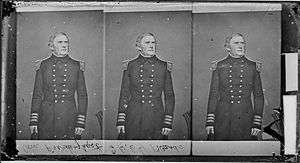Garrett J. Pendergrast
| Garrett Jesse Pendergrast | |
|---|---|
|
Commodore Garrett J. Pendergrast, studio portrait by Mathew Brady | |
| Born |
December 6, 1802 Kentucky |
| Died |
November 7, 1862 (aged 59) Philadelphia, Pennsylvania |
| Buried at | Laurel Hill Cemetery, Philadelphia |
| Allegiance | United States |
| Service/branch | United States Navy |
| Years of service | 1812–1862 |
| Rank |
|
| Commands held | |
| Battles/wars |
War of 1812 Action of 2 March 1825 Mexican-American War American Civil War |
| Relations | Austin Pendergrast (nephew) |
Commodore Garrett Jesse Pendergrast (December 5, 1802 – November 7, 1862) was an officer in the United States Navy, who served at the beginning of the American Civil War.
His nephew was Lieutenant Commander Austin Pendergrast, who during the Civil War took command of USS Congress when she was sunk by CSS Virginia.
Early life and career
Pendergrast entered the navy as a midshipman on January 1, 1812, was promoted to lieutenant on March 3, 1821, and to commander on September 8, 1841.[1]
On 27 October 1843 he recommissioned the sloop Boston at Boston, sailing to the South Atlantic to join the Brazil Squadron, where he remained for over two years, finally returning to the New York Navy Yard in February 1846.[2]
Promoted to Captain on May 24, 1855,[1] he commissioned the frigate Merrimack on February 20, 1856.[3] The ship would later become the CSS Virginia.
On September 24, 1860, Pendergrast sailed from Philadelphia aboard the sloop Pawnee in order to assume command of the Home Squadron, then operating off the coast of Mexico.[4]
Civil War
At the outbreak of war in 1861, Flag Officer Pendergrast was in command of the frigate Cumberland at the Norfolk Navy Yard, having just returned from Vera Cruz, Mexico.[5]
At the age of 58, Pendergrast was one of the oldest officers in service. A native of Kentucky, he was married to Virginia Barron, the daughter of Commodore James Barron. Upon the Secession, she reportedly refused to accompany her husband in his allegiance to the United States and swore she would never live with him again.
The first significant victory for the U.S. Navy during the early phases of the Union blockade occurred on April 24, 1861, when Pendergrast and the Cumberland, accompanied by a small flotilla of support ships, began seizing Confederate ships and privateers in the vicinity of Fort Monroe off the Virginia coastline. Within the next two weeks, Pendergrast had captured 16 enemy vessels, serving early notice to the Confederate War Department that the blockade would be effective if extended.[6]
Promoted to commodore on July 16, 1862,[1] Pendergrast was assigned to command the Philadelphia Navy Yard, and was holding that position when he died of a paralytic stroke on November 7, 1862. He is buried at Laurel Hill Cemetery, Philadelphia.[7]
References
- Notes
- 1 2 3 "US Navy Officers: 1778-1900 (P)". history.navy.mil. 2006. Retrieved 30 March 2012.
- ↑ "USS Boston (IV)". Dictionary of American Naval Fighting Ships. 2006. Retrieved 30 March 2012.
- ↑ "USS Merrimack". Dictionary of American Naval Fighting Ships. 2004. Retrieved 30 March 2012.
- ↑ "USS Pawnee". Dictionary of American Naval Fighting Ships. 2004. Retrieved 30 March 2012.
- ↑ "USS Cumberland". Dictionary of American Naval Fighting Ships. 2004. Retrieved 30 March 2012.
- ↑ Time-Life, p.24.
- ↑ "Garrett J. Pendergrast (1802-1862)". findagrave.com. 2012. Retrieved 30 March 2012.
- Bibliography
- The Civil War. The Blockade: Raiders and Runners. Time–Life Books, 1983.

